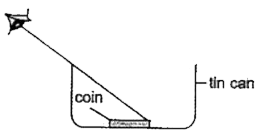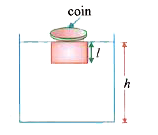In the diagram, the coin is just out of sight. If water is poured into the metal can, the coin will

Become visible
Appear smaller
Not be visible
Float to the surface.
The correct Answer is:A
The refraction of light occurs as it passes from water to air. Hence, the coin appears a little raised and becomes visible.
Topper's Solved these Questions
- BOOK - SCIENCE OLYMPIAD FOUNDATION CHAPTER - LIGHTEXERCISE - ACHIEVERS SECTION (HOTS)5videos
LIGHT
- BOOK - SCIENCE OLYMPIAD FOUNDATION CHAPTER - FRICTION EXERCISE - Achievers Section (HOTS)3videos
FRICTION
- BOOK - SCIENCE OLYMPIAD FOUNDATION CHAPTER - NSO MODEL TEST PAPER -1EXERCISE - ACHIEVERS SECTION2videos
NSO MODEL TEST PAPER -1
Similar Questions
A coin is placed at the bottom of a tin can. Move your eyes until the coin is just out of sight (see diagram). Keep your eyes in this position while someone pours water gradually into the tin can. What would you observe ? Explain your observation.
 View Solution
View SolutionA coin kept in a bowl is not visible when seen from one side. But, when water is poured in the bowl, the coin becomes visible.
View Solution
Knowledge Check
- Question 1 - Select One
A one-rupee coin is placed at the bottom of a vessel. Water
is then poured into the vessel such that the depth of water
becomes 20 cm. If water has refractive index 4/3, the coin
would be seen at a depth ofAa 20 cmBb about 26 cmCc 15 cmDd 25 cm - Question 2 - Select One
A coin placed on a rotating table just slip when it is placed at a distance 4 r from the centre, on doubling the angular velocity of the table , the coin will just slip now the coin is at a distance from centre is
A4 rBr/4CrD2 r - Question 3 - Select One
A coin kept on a rotating gramophone disc just beging to slip if its centre is at a distance of 8 cm from the centre of the disc .The angular velocity of the gramophone disc is then doubled , Through what distance , the coin should be shifted towards the centre , so that the coin will just slip ?
A2 cmB4 cmC6 cmD16 cm
A microscope is focused on a coin lying at the bottom of a beaker. The microscope is now raised up by 1cm. To what depth should the water be poured into the beaker so that coin is again in focus ? (Refractive index of water is 4/3)
View SolutionA piggy bank contains hundred 50 paise coins, fifty Rs. 1 coins, twenty Rs. 2 coins and ten Rs. 5 coins. If it is equally likely that one of the coins will fall out when the bank is turned upside down, find the probability that the coin which fell (i) will be a 50 paise coin (ii) will be of value more than Rs. 1 (iii) will be of value less than Rs. 5 (iv) will be a Rs. 1 or Rs. 2 coin.
View SolutionSomya's saving purse contains hundred 50 p coins, seventy Rs. 1 coins, fifty Rs. 2 coins and thirty Rs. 5 coins.
If it is equally likely that one of the coins will fall out when the purse is turned upside down, then what is the probability that the coin that fell down will be a Rs.1 coins ?View SolutionA wooden block with a coin placed on its top floats in water as shown. After some time the coin falls into water.Then
 View Solution
View SolutionA wooden block, with a coin placed on its top, floats in water as shown in figure. The distance l and h are shown there. After some time the coin falls into the water. Then
 View Solution
View Solution

